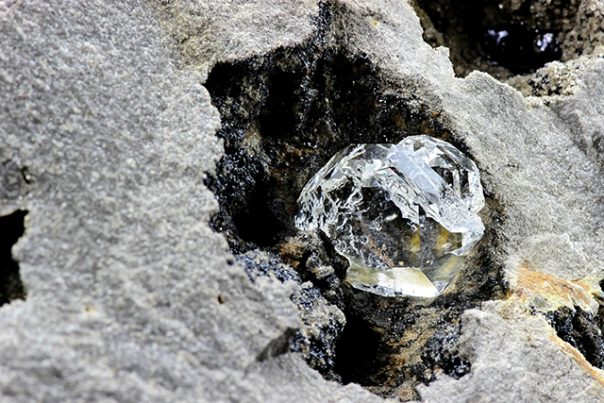
Scientists find evidence of a rare mineral on a tiny South African diamond
Tuesday, June 05, 2018 by David Williams
http://www.realsciencenews.com/2018-06-05-scientists-find-evidence-of-a-rare-mineral-on-a-tiny-south-african-diamond.html

Scientists have managed to discover a rare Earth mineral sitting inside a diamond that was said to be excavated from a South African mine. This mineral, called calcium silicate perovskite (CaSiO3), is a clue as to exactly what happens to the oceanic crust as the Earth goes about its way of recycling it.
As a report on the discovery states, this particular mineral, which is so rare that it has never been found in nature, offers great insight as to how the Earth’s inner structure behaves on the sub-surface level. The diamond wherein the mineral was found trapped came from South Africa’s Cullinan mine, which is also known as the source for the largest diamond in the world.
While this mineral may be rare to humans, scientists have theorized that calcium silicate perovskite may be highly abundant deep beneath the Earth’s surface. There are no official figures, but it is said that it could be the fourth most abundant mineral inside the planet, mainly because it is present in the oceanic crust that may have rolled back into the Earth’s mantle as part of regular tectonic shifts.
According to Graham Pearson, a professor in the University of Alberta‘s Department of Earth and Atmospheric Sciences and a co-author of the study, the mineral is rare because it requires certain special conditions to exist. “Nobody has ever managed to keep this mineral stable at the Earth’s surface,” he explained. “The only possible way of preserving this mineral at the Earth’s surface is when it’s trapped in an unyielding container like a diamond.”
And that explains why it was found trapped inside the diamond that was taken from that South African Cullinan mine. Outside of normal oceanic crust, that’s about the only place where it can be expected to show up, it seems.
Pearson and his colleagues that performed the study focused on a diamond sample that was roughly three millimeters across, with official records stating that it came from a depth of less than one kilometer below the Earth’s surface. Despite this fact, the researchers noted that their diamond sample was likely among those referred to as “deep diamonds” which form about 700 kilometers below the surface.
After polishing the diamond, the researchers found a whole chunk of calcium silicate perovskite within it, and they could see it clearly with the naked eye. The later noted that proper analysis and imaging were both needed, and these required an international effort. For their part, they conducted initial X-ray and spectroscopy tests on the diamond sample, and this helped them confirm that they were indeed looking at calcium silicate perovskite. It is said that this was quite possibly the first intact sample ever seen on the Earth’s surface.
Pearson remarked on the significance of his group’s discovery by saying, “Diamonds are really unique ways of seeing what’s in the Earth.” In his view, the specific composition of the perovskite inclusion in their diamond was a clear indication of recycling of oceanic crust into the Earth’s mantle. “It provides fundamental proof of what happens to the fate of oceanic plates as they descend into the depths of the Earth,” he added. (Related: World rapidly running out of rare minerals needed to manufacture cell phones and mobile devices.)
The researchers are now looking to conduct more tests to find out more about the mineral that they discovered. With more information, perhaps it could be possible to find a proper application for it that would benefit mankind in the real world.
Learn about other rare minerals at Discoveries.news.
Sources include:
Nature.com [PDF]
Tagged Under: Tags: calcium silicate perovskite, diamond, Earth, mantle, minerals, perovskite, science, Silicon





